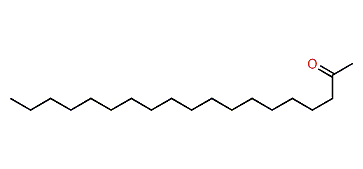|
Semiochemical - 19-2Kt [Nonadecan-2-one]
 |
 |

| Nonadecan-2-one |
| Formula: | C19H38O |
| CAS#: | 629-66-3 |
| MW: | 282.5 |
[MS]
[ Kovats ]
[Occurrence in flower]
|
|
Species utilize Nonadecan-2-one in its chemical communication system
| Squamata, Lacertidae | |
| Gallotia simonyi |
P
¦Category of the chemical signal
| A - | Attractant |
| Al - | Allomone |
| K - | Kairomone |
| P - | Pheromone |
| Sy - | Synomone¦ |
|
¦(*) indicates that compound is active¦
|
El Hierro giant lizard |
| |
| Araneae, Pholcidae, Pholcinae | |
| Pholcus phalangoides |
P
¦Category of the chemical signal
| A - | Attractant |
| Al - | Allomone |
| K - | Kairomone |
| P - | Pheromone |
| Sy - | Synomone¦ |
|
¦(*) indicates that compound is active¦
|
Long-bodied cellar spider |
| |
| Carnivora, Mustelidae, Lutrinae | |
| Aonyx cinerea |
P
¦Category of the chemical signal
| A - | Attractant |
| Al - | Allomone |
| K - | Kairomone |
| P - | Pheromone |
| Sy - | Synomone¦ |
|
¦(*) indicates that compound is active¦
|
Asian short-clawed otter |
| |
| Squamata, Cordylidae, Cordylinae | |
| Cordylus giganteus |
P
¦Category of the chemical signal
| A - | Attractant |
| Al - | Allomone |
| K - | Kairomone |
| P - | Pheromone |
| Sy - | Synomone¦ |
|
¦(*) indicates that compound is active¦
|
Giant girdled lizard |
| |
| Artiodactyla, Bovidae, Cephalophinae, Cephalophini | |
| Sylvicapra grimmia |
P
¦Category of the chemical signal
| A - | Attractant |
| Al - | Allomone |
| K - | Kairomone |
| P - | Pheromone |
| Sy - | Synomone¦ |
|
¦(*) indicates that compound is active¦
|
Common duiker |
| |
| Coleoptera, Bruchidae, Bruchinae, Bruchini | |
| Callosobruchus rhodesianus |
P
¦Category of the chemical signal
| A - | Attractant |
| Al - | Allomone |
| K - | Kairomone |
| P - | Pheromone |
| Sy - | Synomone¦ |
|
¦(*) indicates that compound is active¦
|
|
| |
| Coleoptera, Curculionidae, Erirhininae, Stenopelmini | |
| Oryzophagus oryzae |
Al
¦Category of the chemical signal
| A - | Attractant |
| Al - | Allomone |
| K - | Kairomone |
| P - | Pheromone |
| Sy - | Synomone¦ |
|
¦(*) indicates that compound is active¦
|
South American rice water weevil |
| |
| Hymenoptera, Formicidae, Formicinae, Camponotini | |
| Notoncus ectatommoides |
P
¦Category of the chemical signal
| A - | Attractant |
| Al - | Allomone |
| K - | Kairomone |
| P - | Pheromone |
| Sy - | Synomone¦ |
|
¦(*) indicates that compound is active¦
|
Pronged epaulet ant |
| |
| Hymenoptera, Formicidae, Formicinae, Formicini | |
| Myrmecocystus flaviceps |
P
¦Category of the chemical signal
| A - | Attractant |
| Al - | Allomone |
| K - | Kairomone |
| P - | Pheromone |
| Sy - | Synomone¦ |
|
¦(*) indicates that compound is active¦
|
Yellow-headed honeypot ant |
| Myrmecocystus mexicanus |
P
¦Category of the chemical signal
| A - | Attractant |
| Al - | Allomone |
| K - | Kairomone |
| P - | Pheromone |
| Sy - | Synomone¦ |
|
¦(*) indicates that compound is active¦
|
Mexican honeypot ant |
| |
| Hymenoptera, Formicidae, Formicinae, Lasiini | |
| Lasius alienus |
P
¦Category of the chemical signal
| A - | Attractant |
| Al - | Allomone |
| K - | Kairomone |
| P - | Pheromone |
| Sy - | Synomone¦ |
|
¦(*) indicates that compound is active¦
|
Cornfield ant |
| Lasius fuliginosus |
P
¦Category of the chemical signal
| A - | Attractant |
| Al - | Allomone |
| K - | Kairomone |
| P - | Pheromone |
| Sy - | Synomone¦ |
|
¦(*) indicates that compound is active¦
|
Jet ant |
| |
| Rodentia, Cricetidae, Cricetinae, Cricetini | |
| Phodopus sungorus sungorus |
P
¦Category of the chemical signal
| A - | Attractant |
| Al - | Allomone |
| K - | Kairomone |
| P - | Pheromone |
| Sy - | Synomone¦ |
|
¦(*) indicates that compound is active¦
|
Djungarian hamster |
| |
| Squamata, Lacertidae, Lacertinae, Lacertini | |
| Podarcis lilfordi |
P
¦Category of the chemical signal
| A - | Attractant |
| Al - | Allomone |
| K - | Kairomone |
| P - | Pheromone |
| Sy - | Synomone¦ |
|
¦(*) indicates that compound is active¦
|
Balearic lizard |
| Podarcis muralis |
P
¦Category of the chemical signal
| A - | Attractant |
| Al - | Allomone |
| K - | Kairomone |
| P - | Pheromone |
| Sy - | Synomone¦ |
|
¦(*) indicates that compound is active¦
|
Common wall lizard |
| |
|
|
| |
Citation: El-Sayed AM 2025. The Pherobase: Database of Pheromones and Semiochemicals. <http://www.pherobase.com>.
Ⓒ 2003-2025 The Pherobase - Extensive Database of Pheromones and Semiochemicals. Ashraf M. El-Sayed.
Page created on 20-January-2025
|







